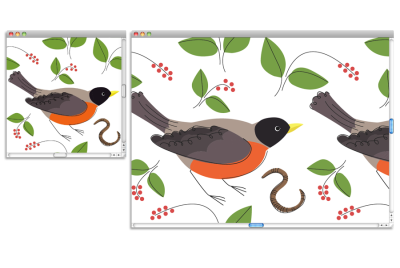Corel Painter Help :
Patterns : Creating and editing patterns
Quick links to procedures on this page:
You can create a pattern from scratch or from an existing image. When creating a pattern from an existing image, you can base the pattern on the entire image or a selected area. You can also create a pattern from a mask, which produces a pattern with a transparent background. The image or selection that you choose is converted into a tile that, when repeated, generates a pattern.
A pattern tile was created by applying brushstrokes to the canvas.
If you want to edit an existing pattern, or if a pattern preview isn’t detailed enough, you can open the pattern tile in its own window so that you can view the pattern closely to modify it. For example, you can manipulate a pattern to be a half-drop design, traditionally used in wallpaper designs.
After creating a pattern tile, you may want to refine it so that it tiles seamlessly. For more information, see Creating seamless patterns.
Images that you turn into patterns are saved in the RIFF format, and they maintain their pattern characteristics even after you save and reopen them. You can switch libraries whenever you want to use a different set of patterns. For more information, see Working with libraries.
Creating patterns on layers
You can use the same techniques to create patterns on layers as you do to create them on the canvas. However, a pattern’s wrap-around features do not apply to layers. This is because the canvas has edges, but layers do not — they are unlimited in size. If you shift a pattern on a layer, the pattern does not wrap around.
|
3
|
Choose Window  Media Control Panels Media Control Panels  Patterns. Patterns. |
|
4
|
In the Patterns panel, click the Pattern options button  , and choose Define Pattern. , and choose Define Pattern. |
|
7
|
In the Save Image dialog box, type a name for the pattern. |

You can also create a pattern by choosing an existing pattern, modifying it, and then choosing Define Pattern.
|
2
|
Choose Window  Media Control Panels Media Control Panels  Patterns. Patterns. |
|
3
|
In the Patterns panel, click the Pattern options button  , and choose Define Pattern. , and choose Define Pattern. |
|
5
|
In the Save Image dialog box, type a name for the pattern. |
|
2
|
Choose Window  Media Control Panels Media Control Panels  Patterns. Patterns. |
|
3
|
Choose the Rectangular Selection tool  from the toolbox. from the toolbox. |
|
5
|
In the Pattern panel, click the Pattern options button  , and choose Capture Pattern. , and choose Capture Pattern. |
|
6
|
In the Capture Pattern dialog box, enable one of the following options: |
|
• |
Rectangular Tile — places the tile in a rectangular grid for fills. This option disables the Bias slider. |
|
8
|
Click OK to save the pattern tile to the current library. |

You can also create a pattern that is based on a 4-point clone source, such as perspective or bilinear. For more information, see Applying transformations when sampling.
|
2
|
Choose Window  Media Control Panels Media Control Panels  Patterns. Patterns. |
|
5
|
In the Patterns panel, click the Pattern options button  , and choose Capture Pattern. , and choose Capture Pattern. |
|
6
|
In the Capture Pattern dialog box, enable one of the following options: |
|
• |
Rectangular Tile — places the tile in a rectangular grid for fills. This option disables the Bias slider. |
|
8
|
Click OK to save the masked pattern to the current library. |

To quickly apply a pattern mask, click the Brush Selector. In the Brush library panel, choose the Pattern Pens category, and then choose the Pattern Pen Masked variant.

You can apply pattern masks by using any brush variant that supports them. For more information, see Painting with patterns.
|
1
|
Choose Window  Media Control Panels Media Control Panels  Patterns. Patterns. |
|
6
|
In the Save Image dialog box, click OK to save the pattern to the library. |

The Check Out Pattern mode supports wrap-around colors. When you drag a brushstroke off one edge of an image, the brushstroke is simultaneously applied to the other side of the image. This allows you to quickly modify the edges of an individual pattern tile.
Copyright 2016 Corel Corporation. All rights reserved.

 , and choose Define Pattern.
, and choose Define Pattern. , and choose Add Image to Library.
, and choose Add Image to Library. , and choose Define Pattern.
, and choose Define Pattern. , and choose Add Image to Library.
, and choose Add Image to Library. from the toolbox.
from the toolbox. , and choose Capture Pattern.
, and choose Capture Pattern. from the toolbox.
from the toolbox. , and choose Capture Pattern.
, and choose Capture Pattern. , and choose Check Out Pattern.
, and choose Check Out Pattern. , and choose Add Image to Library.
, and choose Add Image to Library.